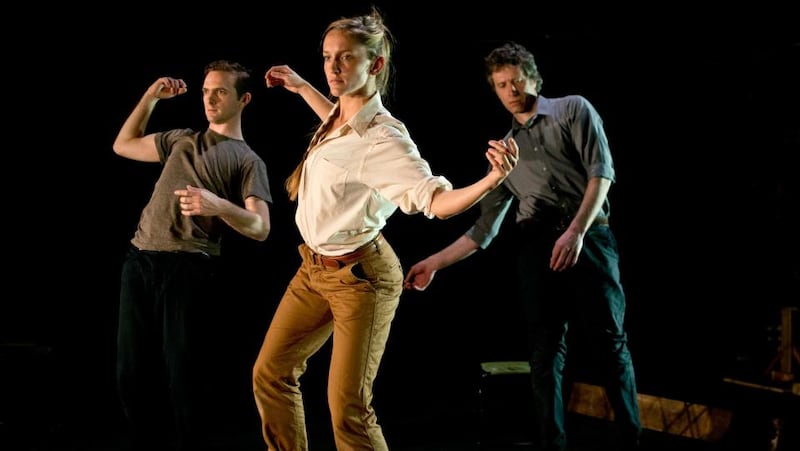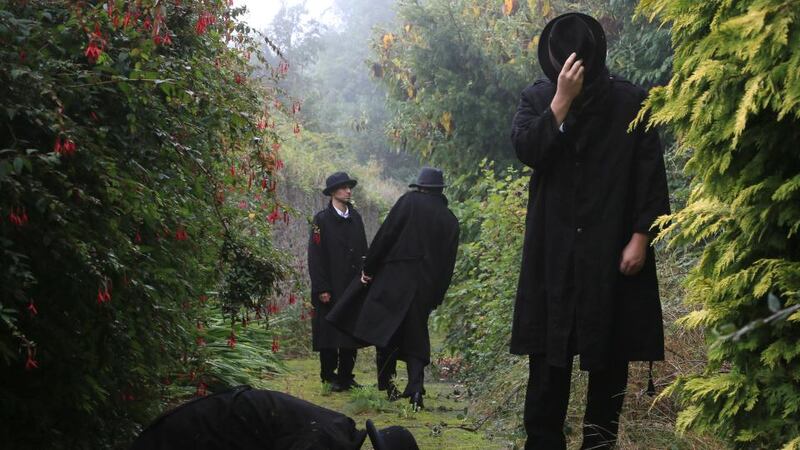A strong sense of place emerged throughout the first week of this year's Dublin Dance Festival, with environments not just as physical entities but also as metaphorical states of being, in the sense of "not being in a good place".
In Emma Martin's Tundra, a bleak landscape is reflected in the dancers' inner emotional landscape, and a similar – if less dramatic – example of environment acting on man comes in Dan Canham's Ours Was the Fen Country. The slowly sinking flatland in east England has always shaped the lives and livelihoods of its inhabitants. Sparsely populated and precariously under sea level, it has created a fiercely isolationist culture that is charmingly articulated through the voices of the community, both pre-recorded and delivered live. "I really think nature is going to win. I hope that it does," says one voice, summing up the complex love/hate relationship between the social and natural landscape.
In The Night of the Big Wind, Claffey Christofi Dance revisits a hurricane that occurred in Ireland in 1839. Unlike Clanham's highly verbal presentation, this dance embodies the folklore around the natural catastrophe, with swirling patterns of stomping turbulence and occasional outbursts of flailing arms.
Bodies in Urban Spaces, by Willi Dorner's Cie, is a conceptually simple work that places inert bodies at different places around the streets of Dublin. And they are bodies, not people. Dressed in bright hoodies and tracksuits, the performers' faces are always hidden and their simple presence urges passers-by to view the built environment anew. The overall effect is a gentle reclamation of the urban space, not through the usual rhetoric of the flash mob, but with sculptural interventions in doorways, between postboxes, up trees or lying on pavements. At the end of a 70- minute walk, the 20 performers receive enthusiastic whooping and clapping from an audience seemingly happy with the abstraction (and smartphones full of cool photos). Reactions from newcomers to dance, in this paper and elsewhere, have articulated frustration at performances that refuse to make narrative sense, but what many choreographers express is an experience that goes beneath narrative.
Liv O'Donoghue's Hear Me Sing Your Song, informally presented and discussed in a studio in DanceHouse, comes from her uncertain identity, having both Norwegian and Irish parentage. This metaphoric in-between space isn't a conveniently storyboarded depiction of her life story, rather the dancers embody thoughts and emotions that resonate broader, often insecure, feelings of community and belonging that are common to everyone.
Choreographers at the Re-Presenting Ireland showcase display similar sure-footedness. Undercurrent, choreographed and performed by Anna Haracz and Dagmara Jerzak, is a beautifully realised exploration of states of mind during sleep, enhanced by a softly looping soundtrack by Dorota Konczewska.
In contrast, Philip Connaughton's sensory outburst, Tardigrade, features live singing, overblown costumes, the choreographer naked in pink body paint, and a trio of dancers. It is dismissive of theatrical conventions, and clear in its intention and delivery, despite being a work in progress.
Wunderbar, by Lara Murphy and Rob Heaslip is a carefully constructed and impeccably performed investigation into partnerships where the dancers seek equilibrium within shifting personal dynamics. All three works are enhanced by strong musical contributions by Konczewska, Michael Gallen and Irene Buckley who all perform or mix their music live.
Cypriot Alexis Vassiliou's two male duets, Please Be Gentle and Stay With Me, impressively delve into issues similar to Wunderbar, this time complicated by the emotional blockages that prevent intimacy and lead to insecurities within the male identity.
Less seriously, in L'après-midi d'un Foehn, Jean Louis Ouvard and eight fans bring plastic-bag puppets to life for an enthusiastic children's audience, who delight in the wizardly and aren't fazed by the Roald Dahl-style darkness of the ending.
The final words of Beckett's The Unnamable are the frequently quoted "You must go on, I can't go on, I'll go on". It sums up the stoicism underpinning much of the action in Arcane Collective's Beckett-inspired Return to Absence, choreographed by Morleigh Steinberg. Inspired by the writer's trilogy of novels – Molloy, Malone Dies and The Unnamable – the dance draws on his rich imagery, pure language and mordant comedy to construct a physical and emotional landscape that somehow finds hope within despair.
Like Cold Dream Colour, the same company's homage to Louis le Broquy that revealed the complex layers beneath the surface of his paintings, Return to Absence delves deep below the narrative. There are some identifiable moments, like the sucking stones from Molloy, but more attention is paid to physical manifestations of the characters' internal struggle. Oguri, Boaz Barkan and Andrés Corchero give sustained performances, with a movement vocabulary that at times draws on Butoh. In these moments, their slowly moving, gnarled limbs embody the twisting futility of existence in Beckett's words.
Elsewhere, they stride purposefully with hunched shoulders dressed in black hats and trenchcoats, or they drag a chair, the friction of its legs against the ground producing a sustained drone that complements Paul Chavez's rich soundscape. Church bells, chickens, classical piano and barely intelligible speech are some of the elements the composer uses elsewhere, while Steinberg, in her role as lighting designer, restricts her colour palette to rich greens tinted with blue or sickly yellow, giving a tonal depth to the movement. The disparate theatrical elements somehow coalesce into an apposite distillation of Beckett's disjointed texts. Like those writings, the result isn't a nihilistic depiction of nonsense, but an almost celebratory exposition of the constant comedy of existence.
Dublin Dance festival runs until Saturday, dublindancefestival.ie













